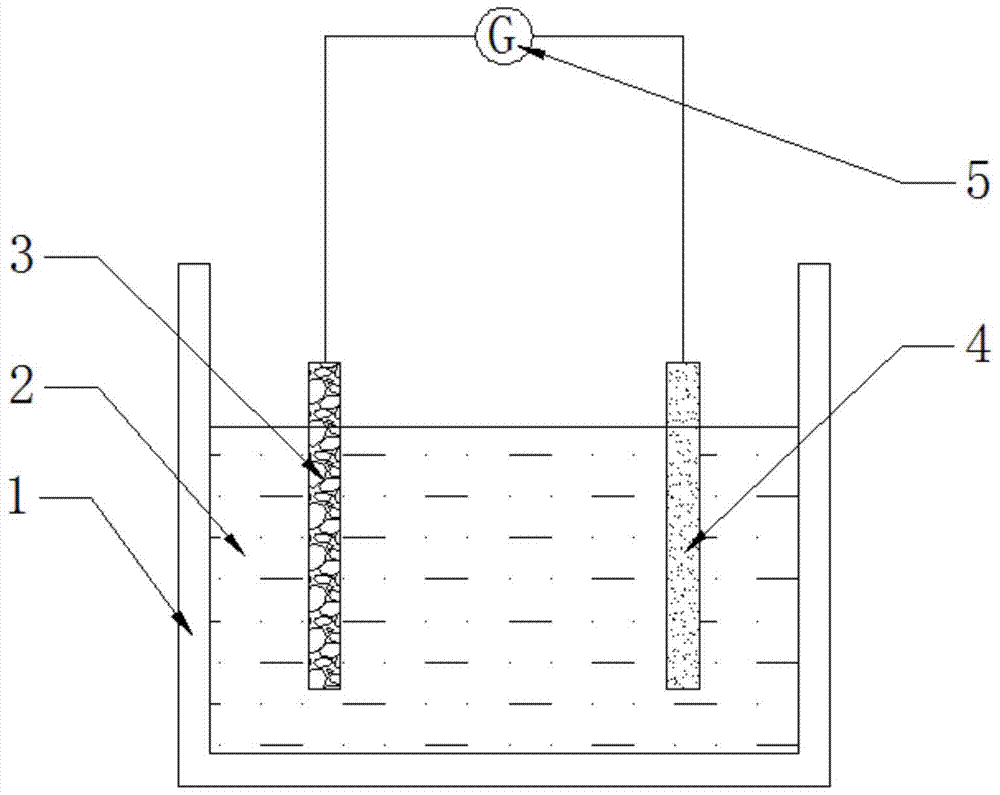An activated metal electrode based on an oxygen-metal battery
A technology of metal batteries and activated metals, which is applied to the electrodes of primary batteries, fuel cell half-cells, and primary battery-type half-cells. It can solve the problems of high infrastructure dependence, excessive discharge, and scarce raw materials. Effect of reducing corrosion and high concentration, reducing negative electrode polarization, and saving resources
- Summary
- Abstract
- Description
- Claims
- Application Information
AI Technical Summary
Problems solved by technology
Method used
Image
Examples
Embodiment 1
[0026] Embodiment 1: Add B element to the activation of Fe
[0027] In this embodiment, the selected added element is B, and the nominal composition is determined to be Fe: B=1:1 (atomic ratio), that is, Fe 50 B 50 , the implementation method is as follows:
[0028] ● Preparation:
[0029] Step 1: Ingredients
[0030] Press Fe 50 B 50 The nominal composition weighs each elemental element and becomes the raw material for preparing the master alloy ingot.
[0031] Step 2: Smelting
[0032] Put the weighed Fe and B elements into the quartz tube, cover the lid, and melt in a vacuum high-frequency induction melting furnace;
[0033] The melting conditions are: the vacuum degree in the vacuum high-frequency induction melting furnace during melting is 8×10 -3 Pa below, filled with 0.5Mpa high-purity argon, smelting for 5-10 minutes.
[0034] Step Three: Spray Casting
[0035] Put the master alloy obtained in step 2 into a vacuum induction metal melt rapid cooling solidifica...
Embodiment 2
[0046] Example 2: Activation of Al by adding Si element
[0047] In this embodiment, the selected additive element is Si, and the nominal composition is determined to be Al:Si=9:1 (atomic ratio), that is, Al 90 Si 10 , the implementation method is as follows:
[0048] ● Preparation:
[0049] Step 1: Ingredients
[0050] Press Al 90 Si 10 The nominal composition weighs each elemental element and becomes the raw material for preparing the master alloy ingot.
[0051] Step 2: Smelting
[0052] Put the weighed Al and Si elements into the copper crucible of the true high arc melting furnace, put Si inside the Al, and melt for 3-4 times.
[0053] The smelting conditions are: the vacuum degree in the vacuum arc melting furnace during smelting is 8×10 -3 Below Pa, fill with 0.5Mpa high-purity argon, smelt for 1-2 minutes each time, and smelt for 3-4 times.
[0054] Step Three: Spray Casting
[0055] Put the master alloy obtained in step 2 into a vacuum induction metal melt q...
Embodiment 3
[0066] Embodiment 3: the activation effect of adding C element to Ti
[0067] In the present embodiment, the selected added element is C, and the nominal composition is determined to be Ti:C=72:28 (atomic ratio), and the implementation method is as follows:
[0068] ● Preparation:
[0069] Step 1: Ingredients
[0070] Press Ti 72 C 28 The nominal composition weighs each elemental element and becomes the raw material for preparing the master alloy ingot.
[0071] Step 2: Smelting
[0072] Put the weighed Ti and C elements into the copper crucible of the true high arc melting furnace, put C on the top of Ti, and melt for 3-4 times.
[0073] The smelting conditions are: the vacuum degree in the vacuum arc melting furnace during smelting is 8×10 -3 Below Pa, fill it with 0.5Mpa high-purity argon, and melt it under 300A current, 1-2 minutes for each melting, and 3-4 times of melting. After the smelting is completed, use a copper crucible with high-pressure cooling water to c...
PUM
| Property | Measurement | Unit |
|---|---|---|
| melting point | aaaaa | aaaaa |
Abstract
Description
Claims
Application Information
 Login to View More
Login to View More - R&D
- Intellectual Property
- Life Sciences
- Materials
- Tech Scout
- Unparalleled Data Quality
- Higher Quality Content
- 60% Fewer Hallucinations
Browse by: Latest US Patents, China's latest patents, Technical Efficacy Thesaurus, Application Domain, Technology Topic, Popular Technical Reports.
© 2025 PatSnap. All rights reserved.Legal|Privacy policy|Modern Slavery Act Transparency Statement|Sitemap|About US| Contact US: help@patsnap.com

